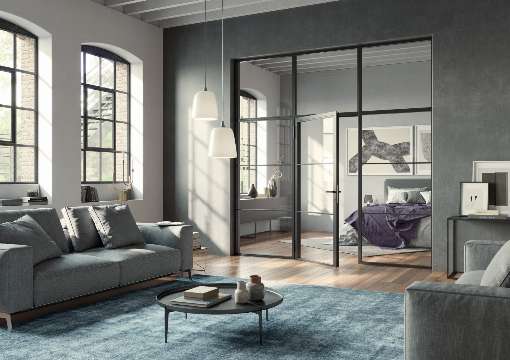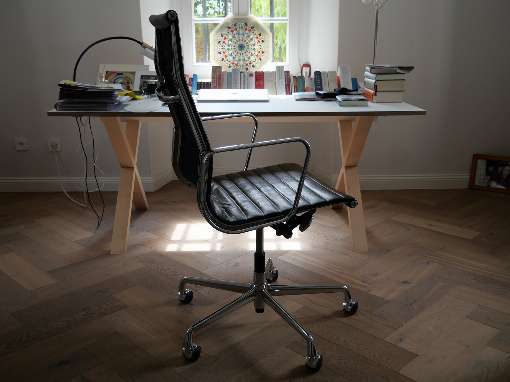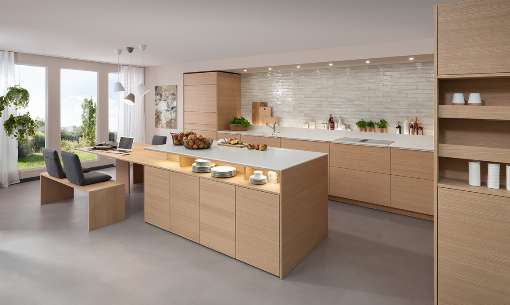02.02.2022
Smart homes and robotics relieve residents of the unloved "side effects" and chores of living. The robot vacuum cleaner vacuums, the lighting is intelligent, the oven cleans itself, the windows close when you leave the house and the heating regulates the temperature all by itself. According to Bitkom, Germany's digital association, spending on smart home technologies increased significantly in 2021. We are smarting up our homes as much as we can. Above-average investments will also be made this year in networking, control, comfort and lighting, energy management, smart household appliances and building security.
Second, as technology advances, the megatrends of digitization and networking will also redefine our own four walls. Activities that used to take place outside the home will increasingly be shifted into our own four walls. Homing in five years means streaming, fitness, gaming, online shopping, mobile working, having food delivered, seeking medical advice on the computer and meeting friends in virtual reality. Even after the pandemic, people will spend up to 75 percent of their free time in their own homes. But as social creatures, people also need social interaction, which will by no means be limited to the weekend. Digital possibilities expand individual time planning, which will have an impact on services, cultural offerings and people's own work rhythms. On Tuesdays, people will sleep in; on Sunday mornings, there will be an online meeting with an international working group. On Mondays, there's a visit to the hairdresser, and on Fridays, there's an online church service. The weekend will suffer an enormous loss of importance, even if private free time should continue to be two days if possible.
What we do at home in 2022:
More tutorials more DIY
We upcycle things, repair household items and pimp our furniture and our entire home. Digitization leads to a desire for analog employment. Many of us are in an acute feasibility dilemma. The major problems of the future are recognized, but we have no idea how to overcome the challenges. So the younger generations in particular are trying to salvage what can be salvaged, at least on a small scale. They document their DIY activities on social media and thus contribute to the sustainable use of objects. Master craftsmen also show their tricks on social channels and motivate people to DIY.
More digital opportunities more home office
By 2030, forecasts say, one in two office workers in Germany will spend all their time at home. The pandemic has greatly accelerated the issue, and politicians are now considering a right to work from home. As a result, occupational health and safety will also be discussed anew. Digital capabilities allow data access and video meetings, but also tracking of activities. Currently, investments are mainly made only in laptops and smartphones, and home office equipment falls by the wayside for many. Ergonomic furniture, such as office chairs and desks, will be just as much a part of home office equipment in the future as good lighting and soundproofing. Since the fusion of living room and workspace is the most likely and practical solution for this development, the equipment will play a decisive role, also for attracting good professionals.
More impulses more color
Colors can make you happier. We've learned that by now from social media and its many shared inspirations. 2022 is the year of application. The bedroom will be painted blue and the kitchen green. By the way, there is also a growing range of green kitchen furniture. They are olive green and avocado, which go well with the color trends of black and wood. Happiness and renewal, lightness and confidence and many other psychological effects are reflected in colors. The color palette is wide in this regard. Panettone sees the color 2022 in "Very Peri", a violet-purple, Caparol recognizes a shade between red and violet. The fact is, this year's trend colors are clearly heading in the warm direction. Cozy, but not old German. Wallpapers, gladly with baroque ornaments, floral patterns or abstract graphics, will find even more sales. Many classic earth tones can be seen. In furniture country Italy, brown is already the new black.
More playful seasonal goods more industrial design
Christmas has just been, Easter is coming. A plethora of decorations are available to us and we are using them extensively. In stark contrast to cool design, Deco is gaining ground and trumping playful accessories. Decorations, accessories and home textiles can be bought everywhere and online, even used and pimped. At the same time, an industrial look is basically popular in interior design. Simplifying and reducing are the order of the day. The home should be tidy and straightforward. The big theme here is square profiles made of black steel. First as table legs, then as door frames, room dividers, mirror frames or sliding doors with a lot of glass surface or transom windows fulfill two wishes: defining and delimiting rooms and yet not being closed off by the transparency or translucency. Mom works in her glass box ... In this way, the residents themselves bring movement into the longstanding, always the same and open floor plan in new apartment construction.
More fast change more slow design
The understanding of quality in terms of design is changing. People are questioning what they buy because they see that their consumption has an impact on the whole planet. Design process, production, materials as well as the topics of sustainability and longevity are coming into focus. Slow design, as in slow fashion and slow food, refers to responsibility for one's own everyday actions. Designers can focus on timelessness and sustainability in the design process of furniture and furnishings, thus counteracting the throwaway culture. "Slow design" can evolve into an economic and entrepreneurial mindset and must answer the question of what comes after the use of the furniture beforehand with.
More sustainability more veneer
Veneer is a trendy all-rounder. Veneer as a furniture surface is increasingly in demand. Oak is still considered particularly attractive, although other wood species such as walnut, maple, birch and also softwoods such as pine and larch are also experiencing good demand in the international furniture industry. Today, people are more interested in a natural furniture surface than they were just a few years ago. Veneer is also experiencing an upswing as a material for home accessories and lifestyle products. In interior design - as a design or sound insulation element - veneer is used more in commercial construction than in private housing.
Initiative Veneer + Nature (IFN)
The Initiative Furnier + Natur (IFN) e.V. was founded in 1996 by the German veneer industry and its partners. Today, it is supported by European companies from the veneer industry, trade and the veneer processing industry as well as trade associations of the wood industry. The aim of the association is to promote veneer as a natural and climate-friendly all-rounder material.
More information on the subject of veneer at:
facebook
linkedin
instagram
furnier.de
Photo 1: Sliding doors with a typical industrial look separate and connect living areas in old and new buildings. Photo: IFN/Hörmann
Photo 2: More and more people are working from home. That's why the home office needs ergonomic furniture. Photo: IFN
Photo 3: A popular evergreen in furniture finishes: Oak veneer. Photo: IFN/Rempp Kitchens
January 27. 2022
Initiative Furnier + Natur e.V. - Bonner Talweg 84 - D-53113 Bonn - m +49 171 1783 444 - www.furnier.de - www.veneer.eu - presse@furnier.de
Housing Trends 2022: Homeization will continue even after the pandemic
Bonn. Our home has many facets. For some it is the place to be with family and friends, for others it is a retreat where we feel safe and secure and for others it is a creative place where we can express ourselves. We change our homes by rearranging, cleaning out, sprucing up and buying new. The managing director of the Initiative Veneer + Nature (IFN) and long-time living analyst Ursula Geismann, summarizes the current developments in the home. Thereby, two striking trends indicate that we will stay at home more even after the pandemic: Smart home innovations and further increasing digitization.Smart homes and robotics relieve residents of the unloved "side effects" and chores of living. The robot vacuum cleaner vacuums, the lighting is intelligent, the oven cleans itself, the windows close when you leave the house and the heating regulates the temperature all by itself. According to Bitkom, Germany's digital association, spending on smart home technologies increased significantly in 2021. We are smarting up our homes as much as we can. Above-average investments will also be made this year in networking, control, comfort and lighting, energy management, smart household appliances and building security.
Second, as technology advances, the megatrends of digitization and networking will also redefine our own four walls. Activities that used to take place outside the home will increasingly be shifted into our own four walls. Homing in five years means streaming, fitness, gaming, online shopping, mobile working, having food delivered, seeking medical advice on the computer and meeting friends in virtual reality. Even after the pandemic, people will spend up to 75 percent of their free time in their own homes. But as social creatures, people also need social interaction, which will by no means be limited to the weekend. Digital possibilities expand individual time planning, which will have an impact on services, cultural offerings and people's own work rhythms. On Tuesdays, people will sleep in; on Sunday mornings, there will be an online meeting with an international working group. On Mondays, there's a visit to the hairdresser, and on Fridays, there's an online church service. The weekend will suffer an enormous loss of importance, even if private free time should continue to be two days if possible.
What we do at home in 2022:
More tutorials more DIY
We upcycle things, repair household items and pimp our furniture and our entire home. Digitization leads to a desire for analog employment. Many of us are in an acute feasibility dilemma. The major problems of the future are recognized, but we have no idea how to overcome the challenges. So the younger generations in particular are trying to salvage what can be salvaged, at least on a small scale. They document their DIY activities on social media and thus contribute to the sustainable use of objects. Master craftsmen also show their tricks on social channels and motivate people to DIY.
More digital opportunities more home office
By 2030, forecasts say, one in two office workers in Germany will spend all their time at home. The pandemic has greatly accelerated the issue, and politicians are now considering a right to work from home. As a result, occupational health and safety will also be discussed anew. Digital capabilities allow data access and video meetings, but also tracking of activities. Currently, investments are mainly made only in laptops and smartphones, and home office equipment falls by the wayside for many. Ergonomic furniture, such as office chairs and desks, will be just as much a part of home office equipment in the future as good lighting and soundproofing. Since the fusion of living room and workspace is the most likely and practical solution for this development, the equipment will play a decisive role, also for attracting good professionals.
More impulses more color
Colors can make you happier. We've learned that by now from social media and its many shared inspirations. 2022 is the year of application. The bedroom will be painted blue and the kitchen green. By the way, there is also a growing range of green kitchen furniture. They are olive green and avocado, which go well with the color trends of black and wood. Happiness and renewal, lightness and confidence and many other psychological effects are reflected in colors. The color palette is wide in this regard. Panettone sees the color 2022 in "Very Peri", a violet-purple, Caparol recognizes a shade between red and violet. The fact is, this year's trend colors are clearly heading in the warm direction. Cozy, but not old German. Wallpapers, gladly with baroque ornaments, floral patterns or abstract graphics, will find even more sales. Many classic earth tones can be seen. In furniture country Italy, brown is already the new black.
More playful seasonal goods more industrial design
Christmas has just been, Easter is coming. A plethora of decorations are available to us and we are using them extensively. In stark contrast to cool design, Deco is gaining ground and trumping playful accessories. Decorations, accessories and home textiles can be bought everywhere and online, even used and pimped. At the same time, an industrial look is basically popular in interior design. Simplifying and reducing are the order of the day. The home should be tidy and straightforward. The big theme here is square profiles made of black steel. First as table legs, then as door frames, room dividers, mirror frames or sliding doors with a lot of glass surface or transom windows fulfill two wishes: defining and delimiting rooms and yet not being closed off by the transparency or translucency. Mom works in her glass box ... In this way, the residents themselves bring movement into the longstanding, always the same and open floor plan in new apartment construction.
More fast change more slow design
The understanding of quality in terms of design is changing. People are questioning what they buy because they see that their consumption has an impact on the whole planet. Design process, production, materials as well as the topics of sustainability and longevity are coming into focus. Slow design, as in slow fashion and slow food, refers to responsibility for one's own everyday actions. Designers can focus on timelessness and sustainability in the design process of furniture and furnishings, thus counteracting the throwaway culture. "Slow design" can evolve into an economic and entrepreneurial mindset and must answer the question of what comes after the use of the furniture beforehand with.
More sustainability more veneer
Veneer is a trendy all-rounder. Veneer as a furniture surface is increasingly in demand. Oak is still considered particularly attractive, although other wood species such as walnut, maple, birch and also softwoods such as pine and larch are also experiencing good demand in the international furniture industry. Today, people are more interested in a natural furniture surface than they were just a few years ago. Veneer is also experiencing an upswing as a material for home accessories and lifestyle products. In interior design - as a design or sound insulation element - veneer is used more in commercial construction than in private housing.
Initiative Veneer + Nature (IFN)
The Initiative Furnier + Natur (IFN) e.V. was founded in 1996 by the German veneer industry and its partners. Today, it is supported by European companies from the veneer industry, trade and the veneer processing industry as well as trade associations of the wood industry. The aim of the association is to promote veneer as a natural and climate-friendly all-rounder material.
More information on the subject of veneer at:
furnier.de
Photo 1: Sliding doors with a typical industrial look separate and connect living areas in old and new buildings. Photo: IFN/Hörmann
Photo 2: More and more people are working from home. That's why the home office needs ergonomic furniture. Photo: IFN
Photo 3: A popular evergreen in furniture finishes: Oak veneer. Photo: IFN/Rempp Kitchens
January 27. 2022
Initiative Furnier + Natur e.V. - Bonner Talweg 84 - D-53113 Bonn - m +49 171 1783 444 - www.furnier.de - www.veneer.eu - presse@furnier.de

Sliding doors with a typical industrial look separate and connect living areas in old and new buildings. Photo: IFN/Hörmann

More and more people are working from home. That's why the home office needs ergonomic furniture. Photo: IFN

A popular evergreen in furniture finishes: Oak veneer. Photo: IFN/Rempp Kitchens